Cleocin (clindamycin) dosing, indications, interactions, adverse effects, and more (original) (raw)
Dosing & Uses
AdultPediatric
Dosage Forms & Strengths
capsule
- 75mg
- 150mg
- 300mg
injectable solution
- 150mg/mL
oral solution
- 75mg/5mL
intravenous ready-to-use solution
- 300 mg/50mL (5% dextrose)
- 600 mg/50mL (5% dextrose)
- 900 mg/50mL (5% dextrose)
Infections
Aerobic gram-positive cocci and the more susceptible anaerobes (NOT generally including Bacteroides fragilis, Peptococcus species and Clostridium species other than Clostridium perfringens)
600–1200 mg/day IV/IM divided BID/QID
More severe infections, particularly those due to proven or suspected Bacteroides fragilis, Peptococcus species, or Clostridium species other than Clostridium perfringens: 1200–2700 mg/day IV/IM divided BID/QID
For more serious infections, these doses may have to be increased; in life-threatening situations due to either aerobes or anaerobes these doses may be increased; doses of as much as 4800 mg qDay given IV to adults
Single intramuscular injections of > 600 mg not recommended
Alternatively, drug may be administered in the form of a single rapid infusion of first dose followed by continuous IV infusion as follows
- To maintain serum levels >4mcg/mL, administer a rapid infusion at 10 mg/min for 30 min followed by maintenance infusion of 0.75 mg/min
- To maintain serum levels >5 mcg/mL, administer a rapid infusion at 15 mg/min for 30 min followed by maintenance infusion of 1 mg/min
- To maintain serum levels >6 mcg/mL, administer a rapid infusion at 20 mg/min for 30 min followed by maintenance infusion of 1.25 mg/min
Serious Infections Caused by Anaerobic Bacteria
150-450 mg PO q6-8hr; not to exceed 1.8 g/day, OR
1.2-2.7 g/day IV/IM divided q6-12hr; not to exceed 4.8 g/day
Amnionitis
450-900 mg IV q8hr
Inhalational & Gastrointestinal Anthrax (Off-label)
900 mg IV q8hr with ciprofloxacin 400 mg PO q12hr or doxycycline 150-300 mg PO q12hr
Bacterial Vaginosis
300 mg PO q12hr for 7 days
Surgical Prophylaxis
900 mg PO/IV 1 hr prior to procedure; may redose q6hr if necessary
Bite Wounds (Human or Animal)
300 mg PO q6hr
Gangrenous Pyomyositis
900 mg IV q8hr with penicillin G
Group B Streptococcus
Neonatal prophylaxis
900 mg IV q8hr until delivery
Orofacial/Parapharyngeal Space Infections
150-450 mg PO q6hr for at least 7 days; not to exceed 1.8 g/day, OR
600-900 mg IV q8hr
Pelvic Inflammatory Disease
900 mg IV q8hr with gentamicin 2 mg/kg; THEN 1.5 mg/kg q8hr; continue after discharge with doxycycline 100 mg PO q12hr to complete 14 days of therapy
Toxic Shock Syndrome
900 mg IV q8hr plus oxacillin or nafcillin (2 g IV q4hr) or vancomycin (30 mg/kg/day IV divided q12hr
Endocarditis Prophylaxis (Off-label)
600 mg PO/IV/IM 30-60 min before procedure
Avoid IM injections in patients receiving anticoagulant therapy; administer PO in these circumstances; in general, administer IV only if patient does not tolerate or is unable to absorp oral medications
Dosing considerations
- Recent AHA guidelines recommend only for high-risk patients undergoing invasive procedures
CNS Toxoplasmosis, With Pyrimethamine or Leucovorin (Off-label)
600 mg IV or PO q6hr for at least 6 weeks
Gardnerella Vaginalis (Off-label)
PO: 300 mg PO q12hr for 7 days
Pneumocystis (Carinii) Jiroveci (Off-label)
30 mg/kg/day divided q6-8hr
300-450 mg PO q6-8hr with primaquine for 21 days
600-900 mg IV q6-8hr with primaquine for 21 days
Sarcoidosis (Orphan)
Orphan indication sponsor
- Autoimmunity Research Foundation; 3423 Hill Canyon Avenue; Thousand Oaks, CA 91360
Administration
PO: May take with food
Dosage Forms & Strengths
capsule
- 75mg
- 150mg
- 300mg
injectable solution
- 150mg/mL
oral solution
- 75mg/5mL
intravenous ready-to-use solution
- 300 mg/50mL (5% dextrose)
- 600 mg/50mL (5% dextrose)
- 900 mg/50mL (5% dextrose)
Infections
<1 month
- 15-20 mg/kg/day IV/IM divided TID/QID
- Postmenstrual (PMA) age ≤32 weeks: 5 mg/kg IV/IM q8hr
- Postmenstrual age ≥32 to 40 weeks: 7 mg/kg IV/IM q8hr
1 month – 16 years
- 20-40 mg/kg/day IV/IM divided TID/QID
- Dose based on total body weight body regardless of obesity
- Alternatively, it may be administered on the basis of square meters body surface: 350 mg/m2/day for serious infections or 450 mg/m2/day for severe infections
- May change parenteral therapy to oral therapy when condition warrants and at discretion of physician
Serious Infections Caused by Anaerobic Bacteria
<7 days
- <2 kg (or >7 days, <1.2 kg): 10 mg/kg/day IV/IM divided q12hr
- >2 kg (or >7 days, 1.2-2 kg): 15 mg/kg/day IV/IM divided q8hr
>7 days
- >2 kg: 20 mg/kg/day IV/IM divided q6hr
<1 month
- 15-20 mg/kg/day divided q6-8hr
>1 month
- Hydrochloride: 8-20 mg/kg/day PO
- Palmitate: 8-25 mg/kg/day divided q6-8hr; 37.5 mg q8hr minimum palmitate dose
Anthrax
15-40 mg/kg/day IV divided q6-8hr
8-25 mg/kg/day PO divided 6-8hr
Endocarditis
Prophylaxis
20 mg/kg PO 30-60 min before procedure, OR
20 mg/kg IV/IM within 30-60 minutes before procedure
Streptococcal Pharyngitis
May consider use in patients allergic to penicillin (IDSA guidelines)
Chronic carrier treatment: 20-30 mg/kg/day PO divided q8hr; not to exceed 300 mg/dose
Acute treatment in penicillin-allergic patients: 7 mg/kg/dose TID for 10 days; not to exceed 300 mg/dose
Orofacial Infections
10-20 mg/kg/day PO divided q6-8hr, OR
15-25 mg/kg/day IV divided q6-8hr
May adjust dose as necessary not to exceed 40 mg/kg/day
Dosing Considerations
IM: No more than 600 mg per injection
Endocarditis: Recent AHA guidelines recommend only for invasive procedures in high-risk patients
Administration
May take with food
Interactions
Interaction Checker
Enter a drug name to check for any interactions. + clindamycin

No Interactions Found
Interactions Found
Contraindicated
Serious
Significant - Monitor Closely
Minor
All Interactions Sort By:

Contraindicated (0)
Serious (11)
- atracurium
clindamycin increases effects of atracurium by pharmacodynamic synergism. Avoid or Use Alternate Drug. Risk of respiratory depression. - BCG vaccine live
clindamycin decreases effects of BCG vaccine live by pharmacodynamic antagonism. Contraindicated. Wait until Abx Tx complete to administer live bacterial vaccine. - cholera vaccine
clindamycin, cholera vaccine. pharmacodynamic antagonism. Avoid or Use Alternate Drug. Avoid coadministration of cholera vaccine with systemic antibiotics since these agents may be active against the vaccine strain. Do not administer cholera vaccine to patients who have received oral or parenteral antibiotics within 14 days prior to vaccination. - cisatracurium
clindamycin increases effects of cisatracurium by pharmacodynamic synergism. Avoid or Use Alternate Drug. Risk of respiratory depression. - microbiota oral
clindamycin decreases effects of microbiota oral by pharmacodynamic antagonism. Avoid or Use Alternate Drug. Microbiota oral contains bacterial spores. Antibacterial agents may decrease efficacy if coadministered. Complete antibiotic regimens 2-4 days before initiating microbiota oral. . - pancuronium
clindamycin increases effects of pancuronium by pharmacodynamic synergism. Avoid or Use Alternate Drug. Risk of respiratory depression. - rapacuronium
clindamycin increases effects of rapacuronium by pharmacodynamic synergism. Avoid or Use Alternate Drug. Risk of respiratory depression. - rocuronium
clindamycin increases effects of rocuronium by pharmacodynamic synergism. Avoid or Use Alternate Drug. Risk of respiratory depression. - succinylcholine
clindamycin increases effects of succinylcholine by pharmacodynamic synergism. Avoid or Use Alternate Drug. Risk of respiratory depression. - typhoid vaccine live
clindamycin decreases effects of typhoid vaccine live by pharmacodynamic antagonism. Contraindicated. Wait until Abx Tx complete to administer live bacterial vaccine. - vecuronium
clindamycin increases effects of vecuronium by pharmacodynamic synergism. Avoid or Use Alternate Drug. Risk of respiratory depression.
Monitor Closely (15)
- bazedoxifene/conjugated estrogens
clindamycin will decrease the level or effect of bazedoxifene/conjugated estrogens by altering intestinal flora. Applies only to oral forms of hormone. Low risk of contraceptive failure. Use Caution/Monitor. - conjugated estrogens
clindamycin will decrease the level or effect of conjugated estrogens by altering intestinal flora. Applies only to oral forms of hormone. Low risk of contraceptive failure. Use Caution/Monitor. - dienogest/estradiol valerate
clindamycin will decrease the level or effect of dienogest/estradiol valerate by altering intestinal flora. Applies only to oral forms of hormone. Low risk of contraceptive failure. Use Caution/Monitor. An alternate or additional form of birth control may be advisable during concomitant use. - digoxin
clindamycin will increase the level or effect of digoxin by altering intestinal flora. Applies only to oral form of both agents. Use Caution/Monitor. - estradiol
clindamycin will decrease the level or effect of estradiol by altering intestinal flora. Applies only to oral forms of hormone. Low risk of contraceptive failure. Use Caution/Monitor. - estrogens conjugated synthetic
clindamycin will decrease the level or effect of estrogens conjugated synthetic by altering intestinal flora. Applies only to oral forms of hormone. Low risk of contraceptive failure. Use Caution/Monitor. - estropipate
clindamycin will decrease the level or effect of estropipate by altering intestinal flora. Applies only to oral forms of hormone. Low risk of contraceptive failure. Use Caution/Monitor. - ethinylestradiol
clindamycin will decrease the level or effect of ethinylestradiol by altering intestinal flora. Applies only to oral forms of hormone. Low risk of contraceptive failure. Use Caution/Monitor. - letermovir
letermovir increases levels of clindamycin by affecting hepatic/intestinal enzyme CYP3A4 metabolism. Use Caution/Monitor. - levonorgestrel oral/ethinylestradiol/ferrous bisglycinate
clindamycin will decrease the level or effect of levonorgestrel oral/ethinylestradiol/ferrous bisglycinate by altering intestinal flora. Applies only to oral forms of hormone. Low risk of contraceptive failure. Use Caution/Monitor. Antibiotics may decrease hormonal contraceptive efficacy. - mestranol
clindamycin will decrease the level or effect of mestranol by altering intestinal flora. Applies only to oral forms of hormone. Low risk of contraceptive failure. Use Caution/Monitor. - mipomersen
mipomersen, clindamycin. Either increases toxicity of the other by Other (see comment). Use Caution/Monitor. Comment: Both drugs have potential to increase hepatic enzymes; monitor LFTs. - nitazoxanide
nitazoxanide, clindamycin. Either increases levels of the other by Mechanism: plasma protein binding competition. Use Caution/Monitor. - ospemifene
clindamycin, ospemifene. Either increases levels of the other by plasma protein binding competition. Modify Therapy/Monitor Closely. - sodium picosulfate/magnesium oxide/anhydrous citric acid
clindamycin decreases effects of sodium picosulfate/magnesium oxide/anhydrous citric acid by altering metabolism. Use Caution/Monitor. Coadministration with antibiotics decreases efficacy by altering colonic bacterial flora needed to convert sodium picosulfate to active drug.
Minor (11)
balsalazide
clindamycin will decrease the level or effect of balsalazide by altering intestinal flora. Applies only to oral form of both agents. Minor/Significance Unknown.biotin
clindamycin will decrease the level or effect of biotin by altering intestinal flora. Applies only to oral form of both agents. Minor/Significance Unknown.erythromycin base
clindamycin, erythromycin base. Either decreases effects of the other by pharmacodynamic antagonism. Minor/Significance Unknown.erythromycin ethylsuccinate
clindamycin, erythromycin ethylsuccinate. Either decreases effects of the other by pharmacodynamic antagonism. Minor/Significance Unknown.erythromycin lactobionate
clindamycin, erythromycin lactobionate. Either decreases effects of the other by pharmacodynamic antagonism. Minor/Significance Unknown.erythromycin stearate
clindamycin, erythromycin stearate. Either decreases effects of the other by pharmacodynamic antagonism. Minor/Significance Unknown.food
food decreases levels of clindamycin by inhibition of GI absorption. Applies only to oral form of both agents. Minor/Significance Unknown.pantothenic acid
clindamycin will decrease the level or effect of pantothenic acid by altering intestinal flora. Applies only to oral form of both agents. Minor/Significance Unknown.pyridoxine
clindamycin will decrease the level or effect of pyridoxine by altering intestinal flora. Applies only to oral form of both agents. Minor/Significance Unknown.pyridoxine (Antidote)
clindamycin will decrease the level or effect of pyridoxine (Antidote) by altering intestinal flora. Applies only to oral form of both agents. Minor/Significance Unknown.thiamine
clindamycin will decrease the level or effect of thiamine by altering intestinal flora. Applies only to oral form of both agents. Minor/Significance Unknown.atracurium
Serious - Use Alternative (1)clindamycin increases effects of atracurium by pharmacodynamic synergism. Avoid or Use Alternate Drug. Risk of respiratory depression.balsalazide
Minor (1)clindamycin will decrease the level or effect of balsalazide by altering intestinal flora. Applies only to oral form of both agents. Minor/Significance Unknown.bazedoxifene/conjugated estrogens
Monitor Closely (1)clindamycin will decrease the level or effect of bazedoxifene/conjugated estrogens by altering intestinal flora. Applies only to oral forms of hormone. Low risk of contraceptive failure. Use Caution/Monitor.BCG vaccine live
Serious - Use Alternative (1)clindamycin decreases effects of BCG vaccine live by pharmacodynamic antagonism. Contraindicated. Wait until Abx Tx complete to administer live bacterial vaccine.biotin
Minor (1)clindamycin will decrease the level or effect of biotin by altering intestinal flora. Applies only to oral form of both agents. Minor/Significance Unknown.cholera vaccine
Serious - Use Alternative (1)clindamycin, cholera vaccine. pharmacodynamic antagonism. Avoid or Use Alternate Drug. Avoid coadministration of cholera vaccine with systemic antibiotics since these agents may be active against the vaccine strain. Do not administer cholera vaccine to patients who have received oral or parenteral antibiotics within 14 days prior to vaccination.cisatracurium
Serious - Use Alternative (1)clindamycin increases effects of cisatracurium by pharmacodynamic synergism. Avoid or Use Alternate Drug. Risk of respiratory depression.conjugated estrogens
Monitor Closely (1)clindamycin will decrease the level or effect of conjugated estrogens by altering intestinal flora. Applies only to oral forms of hormone. Low risk of contraceptive failure. Use Caution/Monitor.dienogest/estradiol valerate
Monitor Closely (1)clindamycin will decrease the level or effect of dienogest/estradiol valerate by altering intestinal flora. Applies only to oral forms of hormone. Low risk of contraceptive failure. Use Caution/Monitor. An alternate or additional form of birth control may be advisable during concomitant use.digoxin
Monitor Closely (1)clindamycin will increase the level or effect of digoxin by altering intestinal flora. Applies only to oral form of both agents. Use Caution/Monitor.erythromycin base
Minor (1)clindamycin, erythromycin base. Either decreases effects of the other by pharmacodynamic antagonism. Minor/Significance Unknown.erythromycin ethylsuccinate
Minor (1)clindamycin, erythromycin ethylsuccinate. Either decreases effects of the other by pharmacodynamic antagonism. Minor/Significance Unknown.erythromycin lactobionate
Minor (1)clindamycin, erythromycin lactobionate. Either decreases effects of the other by pharmacodynamic antagonism. Minor/Significance Unknown.erythromycin stearate
Minor (1)clindamycin, erythromycin stearate. Either decreases effects of the other by pharmacodynamic antagonism. Minor/Significance Unknown.estradiol
Monitor Closely (1)clindamycin will decrease the level or effect of estradiol by altering intestinal flora. Applies only to oral forms of hormone. Low risk of contraceptive failure. Use Caution/Monitor.estrogens conjugated synthetic
Monitor Closely (1)clindamycin will decrease the level or effect of estrogens conjugated synthetic by altering intestinal flora. Applies only to oral forms of hormone. Low risk of contraceptive failure. Use Caution/Monitor.estropipate
Monitor Closely (1)clindamycin will decrease the level or effect of estropipate by altering intestinal flora. Applies only to oral forms of hormone. Low risk of contraceptive failure. Use Caution/Monitor.ethinylestradiol
Monitor Closely (1)clindamycin will decrease the level or effect of ethinylestradiol by altering intestinal flora. Applies only to oral forms of hormone. Low risk of contraceptive failure. Use Caution/Monitor.food
Minor (1)food decreases levels of clindamycin by inhibition of GI absorption. Applies only to oral form of both agents. Minor/Significance Unknown.letermovir
Monitor Closely (1)letermovir increases levels of clindamycin by affecting hepatic/intestinal enzyme CYP3A4 metabolism. Use Caution/Monitor.levonorgestrel oral/ethinylestradiol/ferrous bisglycinate
Monitor Closely (1)clindamycin will decrease the level or effect of levonorgestrel oral/ethinylestradiol/ferrous bisglycinate by altering intestinal flora. Applies only to oral forms of hormone. Low risk of contraceptive failure. Use Caution/Monitor. Antibiotics may decrease hormonal contraceptive efficacy.mestranol
Monitor Closely (1)clindamycin will decrease the level or effect of mestranol by altering intestinal flora. Applies only to oral forms of hormone. Low risk of contraceptive failure. Use Caution/Monitor.microbiota oral
Serious - Use Alternative (1)clindamycin decreases effects of microbiota oral by pharmacodynamic antagonism. Avoid or Use Alternate Drug. Microbiota oral contains bacterial spores. Antibacterial agents may decrease efficacy if coadministered. Complete antibiotic regimens 2-4 days before initiating microbiota oral. .mipomersen
Monitor Closely (1)mipomersen, clindamycin. Either increases toxicity of the other by Other (see comment). Use Caution/Monitor. Comment: Both drugs have potential to increase hepatic enzymes; monitor LFTs.nitazoxanide
Monitor Closely (1)nitazoxanide, clindamycin. Either increases levels of the other by Mechanism: plasma protein binding competition. Use Caution/Monitor.ospemifene
Monitor Closely (1)clindamycin, ospemifene. Either increases levels of the other by plasma protein binding competition. Modify Therapy/Monitor Closely.pancuronium
Serious - Use Alternative (1)clindamycin increases effects of pancuronium by pharmacodynamic synergism. Avoid or Use Alternate Drug. Risk of respiratory depression.pantothenic acid
Minor (1)clindamycin will decrease the level or effect of pantothenic acid by altering intestinal flora. Applies only to oral form of both agents. Minor/Significance Unknown.pyridoxine
Minor (1)clindamycin will decrease the level or effect of pyridoxine by altering intestinal flora. Applies only to oral form of both agents. Minor/Significance Unknown.pyridoxine (Antidote)
Minor (1)clindamycin will decrease the level or effect of pyridoxine (Antidote) by altering intestinal flora. Applies only to oral form of both agents. Minor/Significance Unknown.rapacuronium
Serious - Use Alternative (1)clindamycin increases effects of rapacuronium by pharmacodynamic synergism. Avoid or Use Alternate Drug. Risk of respiratory depression.rocuronium
Serious - Use Alternative (1)clindamycin increases effects of rocuronium by pharmacodynamic synergism. Avoid or Use Alternate Drug. Risk of respiratory depression.sodium picosulfate/magnesium oxide/anhydrous citric acid
Monitor Closely (1)clindamycin decreases effects of sodium picosulfate/magnesium oxide/anhydrous citric acid by altering metabolism. Use Caution/Monitor. Coadministration with antibiotics decreases efficacy by altering colonic bacterial flora needed to convert sodium picosulfate to active drug.succinylcholine
Serious - Use Alternative (1)clindamycin increases effects of succinylcholine by pharmacodynamic synergism. Avoid or Use Alternate Drug. Risk of respiratory depression.thiamine
Minor (1)clindamycin will decrease the level or effect of thiamine by altering intestinal flora. Applies only to oral form of both agents. Minor/Significance Unknown.typhoid vaccine live
Serious - Use Alternative (1)clindamycin decreases effects of typhoid vaccine live by pharmacodynamic antagonism. Contraindicated. Wait until Abx Tx complete to administer live bacterial vaccine.vecuronium
Serious - Use Alternative (1)clindamycin increases effects of vecuronium by pharmacodynamic synergism. Avoid or Use Alternate Drug. Risk of respiratory depression.
Adverse Effects
Frequency Not Defined
Abdominal pain
Agranulocytosis
Eosinophilia (transient)
Diarrhea
Fungal overgrowth
Pseudomembranous colitis
Hypersensitivity
Stevens-Johnson syndrome
Rashes
Urticaria
Hypotension
Nausea
Vomiting
Sterile abscess at IM site
Thrombophlebitis
Granulocytopenia
Neutropenia
Thrombocytopenia
Polyarthritis
Renal dysfunction
Postmarketing reports
Metallic taste
Clostridium difficile colitis
Acute generalized exanthematous pustulosis (AGEP)
Erythema multiforme, some resembling Stevens-Johnson syndrome
Acute kidney injury
Drug reaction with eosinophilia and systemic symptoms (DRESS)
Esophagitis and esophageal ulcer, particularly when taken in lying position or with small amount of water
Warnings
Black Box Warnings
Clostridium difficile-associated diarrhea (CDAD) has been reported and may range in severity from mild diarrhea to fatal colitis
C difficile produces toxins A and B, which contribute to CDAD; hypertoxin-producing C difficile strains increase morbidity and mortality (more likely to be refractory to antimicrobial therapy and may require colectomy)
If CDAD suspected or confirmed, ongoing antibiotic use not directed against C difficile may need to be discontinued
Contraindications
Hypersensitivity to clindamycin, lincomycin, or formulation components
Cautions
Clindamycin is potentially nephrotoxic; acute kidney injury including acute renal failure reported; consider monitoring of renal function of patients with pre-existing renal dysfunction or taking concomitant nephrotoxic drugs; monitoring of renal function should be performed if therapy is prolonged
Endocarditis prophylaxis: Use only for high-risk patients, per recent AHA guidelines
Due to risk of esophagitis and esophageal ulcer, important to ensure adherence with administration guidance
Risk of potentially fatal pseudomembranous colitis, fungal or bacterial superinfection on prolonged use; discontinue therapy if significant abdominal cramps, diarrhea, or passage of blood and mucus occurs
May increase risk of drug-resistant bacteria if prescribed in the absence of proven or strongly suspected bacterial infection
Use caution in hepatic impairment, monitor for hepatic abnormalities; periodic liver enzyme determinations should be made when treating patients with severe liver disease
Not for use in meningitis due to inadequate penetration into CSF
Severe skin reactions including toxic epidermal necrolysis, drug reaction with eosinophilia and systemic symptoms (DRESS), and Stevens-Johnson syndrome (SJS), some with fatal outcome, reported; permanently discontinue if reactions occur
Parenteral product contains benzyl alcohol, which has been associated with gasping syndrome and death in newborns
Use with caution in patients with history of gastrointestinal disease, especially colitis
Not for administration as a bolus; infuse over 10-60 min
Consider possibility of clostridium difficile in all patients who present with diarrhea following antibiotic use
Serious anaphylactic reactions require immediate emergency treatment with epinephrine; oxygen and intravenous corticosteroids should also be administered as indicated
Prescribe with caution in atopic individuals
Indicated surgical procedures should be performed in conjunction with antibiotic therapy
Clindamycin dosage modification may not be necessary in patients with renal disease
Discontinue therapy permanently and institute appropriate therapy if anaphylactic or severe hypersensitivity reaction occurs
When solution is administered to pediatric population (birth to 16 years) appropriate monitoring of organ system functions is desirable
Toxicity in neonates
- Product contains benzyl alcohol as a preservative; administration of intravenous solutions containing preservative benzyl alcohol has been associated with the “gasping syndrome”, and death in neonates
- Symptoms include a striking onset of gasping respiration, hypotension, bradycardia, and cardiovascular collapse
- Although the normal therapeutic dose of this product delivers amounts of benzyl alcohol that are substantially lower than those reported in association with “gasping syndrome,” minimum amount of benzyl alcohol at which toxicity may occur is not known and total daily benzyl alcohol exposure may be increased by concomitant medications
- The risk of benzyl alcohol toxicity depends on quantity administered and liver and kidneys’ capacity to detoxify the chemical; premature and low birth weight infants may be more likely to develop toxicity
Pregnancy & Lactation
Pregnancy
In clinical trials with pregnant women, systemic administration of clindamycin during the second and third trimesters, has not been associated with increased frequency of congenital abnormalities
Clindamycin should be used during first trimester of pregnancy only if clearly needed; there are no adequate and well-controlled studies in pregnant women during first trimester of pregnancy. Because animal reproduction studies are not always predictive of the human response, this drug should be used during pregnancy only if clearly needed
Lactation
Clindamycin has been reported to appear in breast milk in range of 0.5 to 3.8 mcg/mL; clindamycin has potential to cause adverse effects on breastfed infant's gastrointestinal flora; if oral or intravenous clindamycin is required by nursing mother, it is not a reason to discontinue breastfeeding, but alternate drug may be preferred; monitor infant for possible adverse effects on gastrointestinal flora, such as diarrhea, candidiasis (thrush, diaper rash) or rarely, blood in stool indicating possible antibiotic-associated colitis
The developmental and health benefits of breastfeeding should be considered along with mother's clinical need for clindamycin and any potential adverse effects on breastfed child from clindamycin or from underlying maternal condition
Pregnancy Categories
A: Generally acceptable. Controlled studies in pregnant women show no evidence of fetal risk.
B: May be acceptable. Either animal studies show no risk but human studies not available or animal studies showed minor risks and human studies done and showed no risk.
C: Use with caution if benefits outweigh risks. Animal studies show risk and human studies not available or neither animal nor human studies done.
D: Use in LIFE-THREATENING emergencies when no safer drug available. Positive evidence of human fetal risk.
X: Do not use in pregnancy. Risks involved outweigh potential benefits. Safer alternatives exist.
NA: Information not available.
Pharmacology
Mechanism of Action
Suppresses protein synthesis by binding to 50S ribosomal subunits; bacteriostatic or bactericidal depending on drug concentration, organism and infection site
Absorption
Bioavailability: Oral (rapid; 90%)
Peak serum time: Within 60 min (PO); 1-3 hr (IM)
Distribution
High concentrations in bone and urine
No significant levels in CSF, even with inflamed meninges
Crosses placenta; enters breast milk
Vd: ~2 L/kg
Metabolism
Hepatic
Elimination
Half-life: 2-3 hr (adults); 8.7 hr (premature neonates); 3.6 hr (full-term neonates); 2 hr (children); 4 hr (elderly)
Excretion: Urine (10%) as active drug; feces (~4%) as active drug
Administration
IV Incompatibilities
Additive: Aminophylline, ceftriaxone, ciprofloxacin, gentamicin/cefazolin, ranitidine(?)
Syringe: Tobramycin
Y-site: Allopurinol, azithromycin, doxapram, filgrastim, fluconazole, idarubicin
Reported to be physically incompatible with aminophylline, ampicillin, barbiturates, Ca-gluconate, magnesium sulfate, and phenytoin; other reports say ampicillin is additive compatible and magnesium sulfate is Y-site compatible
IV Compatibilities
Solution: Compatible with most common diluents
Additive: Amikacin, aztreonam, cefazolin, cefepime, cefoperazone, cefotaxime, cefoxitin, ceftazidime, cefuroxime, cimetidine, fluconazole, gentamicin, heparin, hydrocortisone, kanamycin, methylprednisolone, metoclopramide, metronidazole, netilmicin, ofloxacin, KCl, penicillin G, piperacillin, Na-bicarbonate, tobramycin, verapamil, vitamin B/C
Syringe: Amikacin, aztreonam, caffeine, gentamicin, heparin
Y-site: Amifostine, amiodarone, amphotericin B CholSO4, amsacrine, aztreonam, bivalirudin, cefpirome, cisatracurium, cyclophosphamide, dexmedetomidine, diltiazem, docetaxel, doxorubicin liposomal, enalaprilat, esmolol, etoposide PO4, fenoldopam, fludarabine, foscarnet, gatifloxacin, gemcitabine, granisetron, hetastarch, hydromorphone, heparin, labetalol, levofloxacin, linezolid, meperidine, morphine, midazolam, milrinone, nicardipine, ondansetron, perphenazine, piperacillin/tazobactam, propofol, remifentanil, sargramostim, tacrolimus, teniposide, theophylline, thiotepa, vinorelbine, vitamin B/C, zidovudine
IV Preparation
150 mg/mL solution for injection must be diluted before infused IV
Dilute 300 and 600 mg in 50 mL of D5W
Dilute 900 mg in 50-100 mL of D5W
Dilute 1200 mg in 100 mL of D5W
IV Administration
Intermittent IV infusion
- Infuse over 10-60 min at a rate not exceeding 30 mg/min
- See manufacturer's PI for rapid and maintenance rates for specific desired serum levels
- 300 mg doses infuse over 10 min
- 600 mg doses infuse over 20 min
- 900 mg doses infuse over 30 min
- 1200 mg doses infuse over 60 min; no more than 1200 mg of drug should be given by IV infusion in 1 hr
Continuous IV infusion
- May give continuous IV infusion instead of intermittent after first dose has been given by rapid IV infusion
Images

| BRAND | FORM. | UNIT PRICE | PILL IMAGE |
|---|---|---|---|
| Cleocin vaginal- | 100 mg suppos | 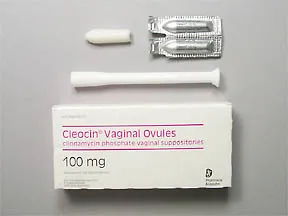 |
|
| Cleocin vaginal- | 2 % cream | 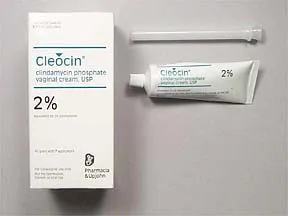 |
|
| Clindagel topical- | 1 % gel | 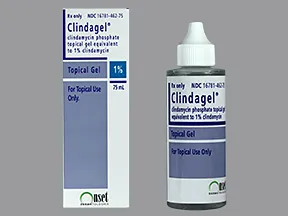 |
|
| clindamycin phosphate topical- | 1 % lotion |  |
|
| clindamycin phosphate topical- | 1 % foam |  |
|
| clindamycin phosphate topical- | 1 % gel | 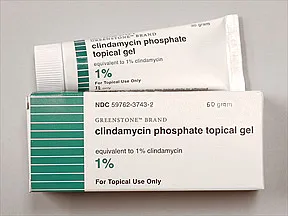 |
|
| clindamycin phosphate topical- | 1 % solution |  |
|
| clindamycin phosphate topical- | 1 % lotion |  |
|
| clindamycin phosphate topical- | 1 % foam | 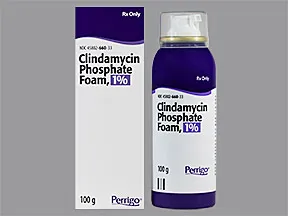 |
|
| clindamycin phosphate topical- | 1 % solution | 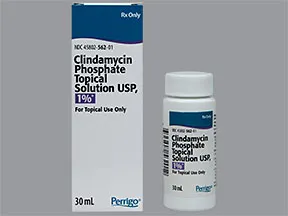 |
|
| clindamycin phosphate topical- | 1 % solution | 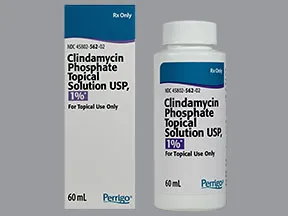 |
|
| clindamycin phosphate topical- | 1 % gel | 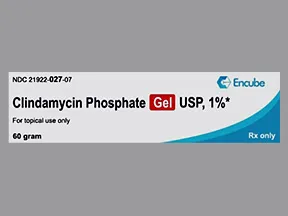 |
|
| clindamycin phosphate topical- | 1 % gel |  |
|
| clindamycin phosphate topical- | 1 % gel | 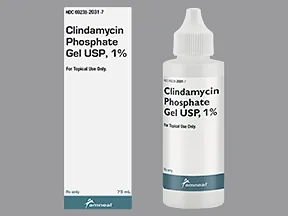 |
|
| clindamycin phosphate topical- | 1 % lotion | 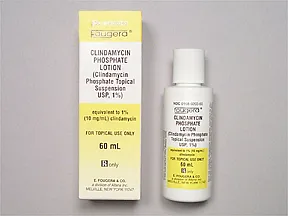 |
|
| clindamycin phosphate topical- | 1 % gel | 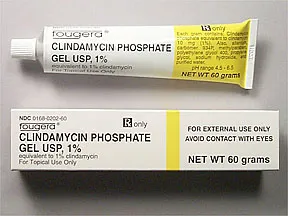 |
|
| clindamycin phosphate topical- | 1 % gel | 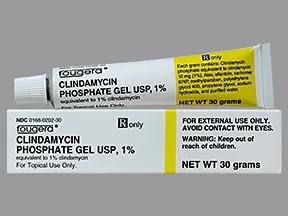 |
|
| clindamycin phosphate topical- | 1 % solution | 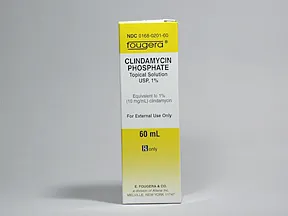 |
|
| clindamycin phosphate topical- | 1 % solution | 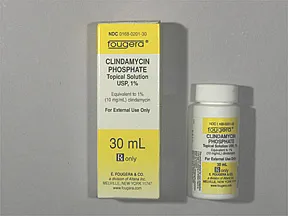 |
|
| clindamycin phosphate topical- | 1 % solution | 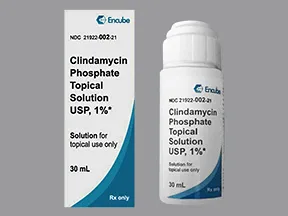 |
|
| clindamycin phosphate topical- | 1 % solution | 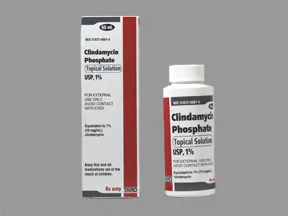 |
|
| clindamycin phosphate topical- | 1 % solution | 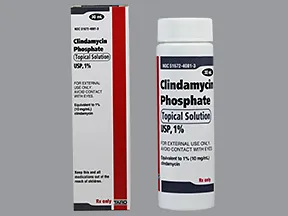 |
|
| clindamycin phosphate topical- | 1 % lotion |  |
|
| clindamycin phosphate topical- | 1 % gel | 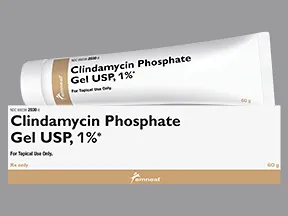 |
|
| clindamycin phosphate topical- | 1 % gel |  |
|
| clindamycin phosphate topical- | 1 % solution | 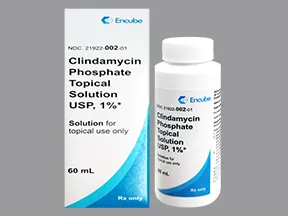 |
|
| clindamycin phosphate topical- | 1 % solution |  |
|
| clindamycin phosphate topical- | 1 % gel | 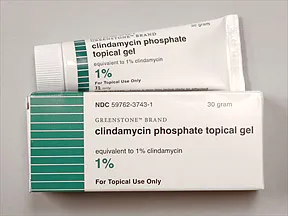 |
|
| clindamycin phosphate topical- | 1 % gel |  |
|
| clindamycin phosphate topical- | 1 % gel |  |
|
| clindamycin phosphate topical- | 1 % swab | 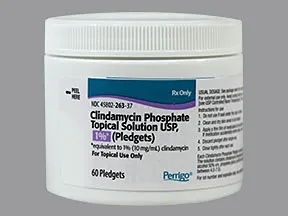 |
|
| clindamycin phosphate topical- | 1 % gel | 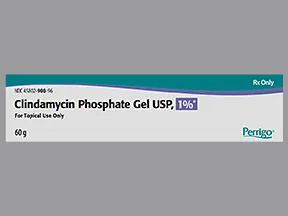 |
|
| clindamycin phosphate topical- | 1 % gel | 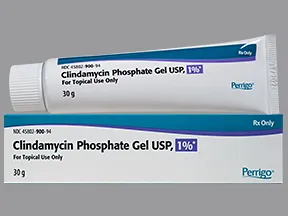 |
|
| clindamycin phosphate topical- | 1 % gel |  |
|
| clindamycin phosphate topical- | 1 % gel |  |
|
| Clindacin ETZ topical- | 1 % swab | 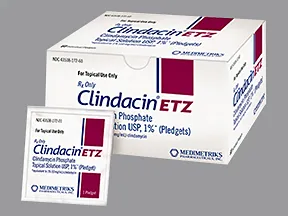 |
|
| Clindacin ETZ topical- | 1 % kit | 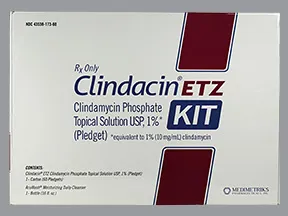 |
|
| Clindacin ETZ topical- | 1 % swab | 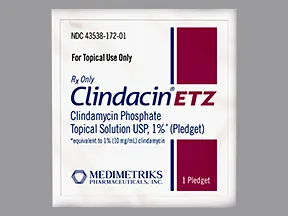 |
|
| clindamycin vaginal- | 2 % cream | 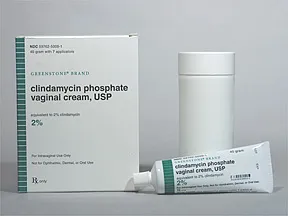 |
|
| clindamycin vaginal- | 2 % cream | 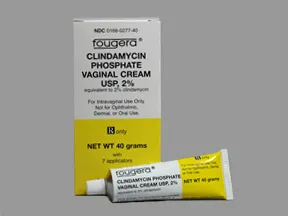 |
|
| Cleocin T topical- | 1 % lotion | 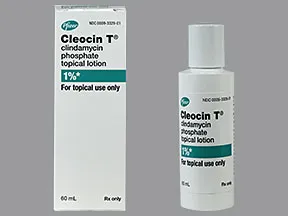 |
|
| Cleocin injection- | 150 mg/mL vial |  |
|
| Cleocin injection- | 150 mg/mL vial |  |
|
| Cleocin injection- | 150 mg/mL vial |  |
|
| Cleocin injection- | 150 mg/mL vial |  |
|
| Cleocin injection- | 150 mg/mL vial |  |
|
| clindamycin injection- | 150 mg/mL vial | 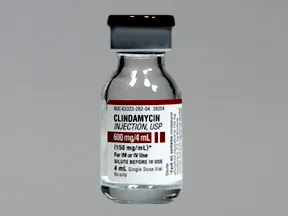 |
|
| clindamycin injection- | 150 mg/mL vial | 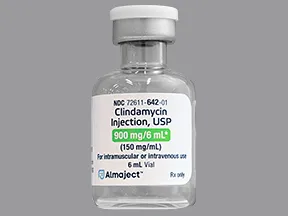 |
|
| clindamycin injection- | 150 mg/mL vial | 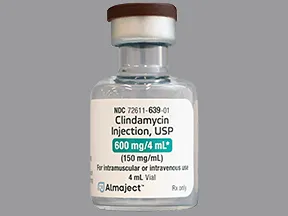 |
|
| clindamycin injection- | 150 mg/mL vial |  |
|
| clindamycin injection- | 150 mg/mL vial |  |
|
| clindamycin injection- | 150 mg/mL vial | 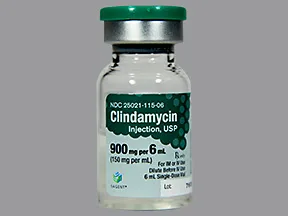 |
|
| clindamycin injection- | 150 mg/mL vial | 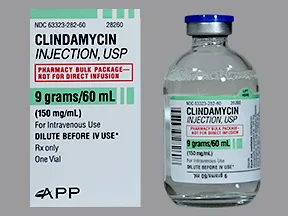 |
|
| clindamycin injection- | 150 mg/mL vial | 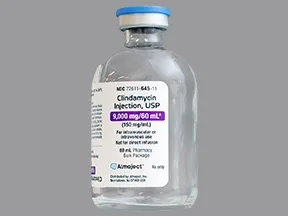 |
|
| clindamycin injection- | 150 mg/mL vial | 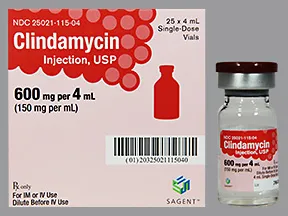 |
|
| clindamycin injection- | 150 mg/mL vial | 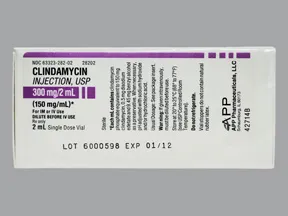 |
|
| clindamycin injection- | 150 mg/mL vial | 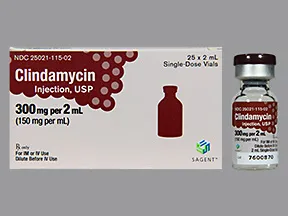 |
|
| Clindacin P topical- | 1 % swab | 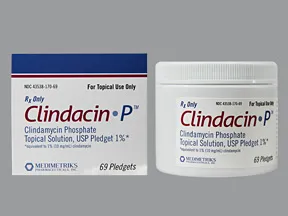 |
|
| Clindesse vaginal- | 2 % cream | 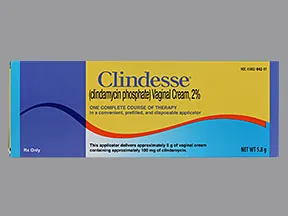 |
Copyright © 2010 First DataBank, Inc.
Patient Handout


CLINDAMYCIN - TOPICAL
(klin-duh-MY sin)
COMMON BRAND NAME(S): Cleocin T, Clinda-Derm
USES: This medication is used to treat acne. It helps to decrease the number of acne lesions. Clindamycin is an antibiotic which works by stopping the growth of bacteria.
HOW TO USE: Use this medication only on the skin. Clean and dry the affected area first. Follow all directions on the product package, or use as directed by your doctor.If you are using the lotion, shake the bottle well before using. Apply a thin layer of medication to the affected area as directed by your doctor, usually twice a day.If you are using the medicated pad or swab, apply to the the affected area gently with it, then discard. Depending on the size of the area to be treated, more than one pad or swab may be necessary.If you are using the foam, apply it to the affected areas as directed by your doctor, usually once daily. Use enough to cover the entire affected area. Do not spray the foam directly onto your hands or face, because the foam will begin to melt on contact with warm skin. Instead spray the amount needed directly into the cap or onto a cool surface such as a counter top. If the can seems warm or the foam seems runny, run the can under cold water. Please read the patient information leaflet available from your pharmacist for specific instructions on how to use the foam, and ask about any information that is unclear.Wash your hands after use.Avoid contact with your eyes, nose, mouth or any areas of broken skin. If you accidentally get medication in these areas, rinse well with plenty of cool water.It may take between 2 to 6 weeks to notice an improvement in your condition, and up to 12 weeks to see the full benefit.Tell your doctor if your condition does not improve or worsens.
SIDE EFFECTS: Burning, itching, dryness, redness, oily skin or skin peeling may occur. If any of these effects last or get worse, tell your doctor or pharmacist promptly.Remember that this medication has been prescribed because your doctor has judged that the benefit to you is greater than the risk of side effects. Many people using this medication do not have serious side effects.This medication may be absorbed into your bloodstream and very rarely cause a severe intestinal condition due to a bacteria called C. difficile. This condition may occur during treatment or weeks to months after treatment has stopped. Tell your doctor right away if you develop: diarrhea that doesn't stop, abdominal or stomach pain/cramping, blood/mucus in your stool.If you have these symptoms, do not use anti-diarrhea or opioid products because they may make symptoms worse.A very serious allergic reaction to this drug is rare. However, get medical help right away if you notice any symptoms of a serious allergic reaction, including: rash, itching/swelling (especially of the face/tongue/throat), severe dizziness, trouble breathing.This is not a complete list of possible side effects. If you notice other effects not listed above, contact your doctor or pharmacist.In the US -Call your doctor for medical advice about side effects. You may report side effects to FDA at 1-800-FDA-1088 or at www.fda.gov/medwatch.In Canada - Call your doctor for medical advice about side effects. You may report side effects to Health Canada at 1-866-234-2345.
PRECAUTIONS: Before using clindamycin, tell your doctor or pharmacist if you are allergic to it; or to lincomycin; or if you have any other allergies. This product may contain inactive ingredients, which can cause allergic reactions or other problems. Talk to your pharmacist for more details.Before using this medication, tell your doctor or pharmacist your medical history, especially of: chronic asthma or hay fever (atopic conditions), intestinal diseases (such as ulcerative colitis, enteritis, C. difficile-associated diarrhea).Before having surgery, tell your doctor or dentist about all the products you use (including prescription drugs, nonprescription drugs, and herbal products).Tell your doctor if you are pregnant before using this medication.It is unknown if the medication in this product passes into breast milk. While there have been no reports of harm to nursing infants, consult your doctor before breastfeeding.
DRUG INTERACTIONS: Drug interactions may change how your medications work or increase your risk for serious side effects. This document does not contain all possible drug interactions. Keep a list of all the products you use (including prescription/nonprescription drugs and herbal products) and share it with your doctor and pharmacist. Do not start, stop, or change the dosage of any medicines without your doctor's approval.
OVERDOSE: If someone has overdosed and has serious symptoms such as passing out or trouble breathing, call 911. Otherwise, call a poison control center right away. US residents can call 1-800-222-1222. Canada residents can call 1-844-764-7669. This medication may be harmful if swallowed.
NOTES: Do not share this medication with others.
MISSED DOSE: If you miss a dose, apply it as soon as you remember. If it is near the time of the next dose, skip the missed dose. Use your next dose at the regular time. Do not double the dose to catch up.
STORAGE: Different brands of this medication have different storage needs. Check the product package for instructions on how to store your brand, or ask your pharmacist. Keep all medications away from children and pets.Do not flush medications down the toilet or pour them into a drain unless instructed to do so. Properly discard this product when it is expired or no longer needed. Consult your pharmacist or local waste disposal company.
Information last revised May 2024. Copyright(c) 2024 First Databank, Inc.
IMPORTANT: HOW TO USE THIS INFORMATION: This is a summary and does NOT have all possible information about this product. This information does not assure that this product is safe, effective, or appropriate for you. This information is not individual medical advice and does not substitute for the advice of your health care professional. Always ask your health care professional for complete information about this product and your specific health needs.
Formulary
FormularyPatient Discounts
Adding plans allows you to compare formulary status to other drugs in the same class.
To view formulary information first create a list of plans. Your list will be saved and can be edited at any time.
Adding plans allows you to:
- View the formulary and any restrictions for each plan.
- Manage and view all your plans together – even plans in different states.
- Compare formulary status to other drugs in the same class.
- Access your plan list on any device – mobile or desktop.
The above information is provided for general informational and educational purposes only. Individual plans may vary and formulary information changes. Contact the applicable plan provider for the most current information.
View explanations for tiers and restrictions
| Tier | Description |
|---|---|
| 1 | This drug is available at the lowest co-pay. Most commonly, these are generic drugs. |
| 2 | This drug is available at a middle level co-pay. Most commonly, these are "preferred" (on formulary) brand drugs. |
| 3 | This drug is available at a higher level co-pay. Most commonly, these are "non-preferred" brand drugs. |
| 4 | This drug is available at a higher level co-pay. Most commonly, these are "non-preferred" brand drugs or specialty prescription products. |
| 5 | This drug is available at a higher level co-pay. Most commonly, these are "non-preferred" brand drugs or specialty prescription products. |
| 6 | This drug is available at a higher level co-pay. Most commonly, these are "non-preferred" brand drugs or specialty prescription products. |
| NC | NOT COVERED – Drugs that are not covered by the plan. |
| Code | Definition |
|---|---|
| PA | Prior Authorization Drugs that require prior authorization. This restriction requires that specific clinical criteria be met prior to the approval of the prescription. |
| QL | Quantity Limits Drugs that have quantity limits associated with each prescription. This restriction typically limits the quantity of the drug that will be covered. |
| ST | Step Therapy Drugs that have step therapy associated with each prescription. This restriction typically requires that certain criteria be met prior to approval for the prescription. |
| OR | Other Restrictions Drugs that have restrictions other than prior authorization, quantity limits, and step therapy associated with each prescription. |
Non-Medicare Plans Medicare Plans
From:
To:
The recipient will receive more details and instructions to access this offer.
By clicking send, you acknowledge that you have permission to email the recipient with this information.
From:
To:
The recipient will receive more details and instructions to access this offer.
By clicking send, you acknowledge that you have permission to email the recipient with this information.
Medscape prescription drug monographs are based on FDA-approved labeling information, unless otherwise noted, combined with additional data derived from primary medical literature.